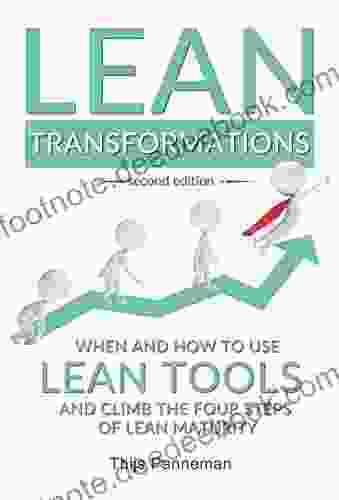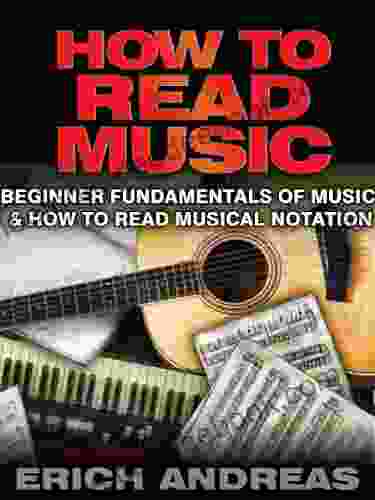The Comprehensive Guide to Reading Music: Unlocking the Language of Music

Music is a universal language that can be enjoyed by people of all cultures. But in order to truly appreciate music, it is important to be able to read it. Reading music is not as difficult as it may seem, and with a little practice, anyone can learn how to do it.
In this guide, we will teach you everything you need to know about reading music, from the basics of musical notation to more advanced concepts. We will also provide you with plenty of practice exercises to help you develop your skills. So whether you are a beginner or an experienced musician, this guide has something for you.
4.4 out of 5
| Language | : | English |
| File size | : | 1501 KB |
| Text-to-Speech | : | Enabled |
| Screen Reader | : | Supported |
| Enhanced typesetting | : | Enabled |
| Word Wise | : | Enabled |
| Print length | : | 78 pages |
| Lending | : | Enabled |
| X-Ray | : | Enabled |
The Basics of Musical Notation
Musical notation is a system of symbols that is used to represent music. These symbols include notes, rests, clefs, and time signatures. Notes represent the pitch and duration of a sound, while rests represent silence. Clefs determine the range of notes that can be played on a particular instrument, and time signatures tell you how many beats are in each measure.
The most common clefs are the treble clef and the bass clef. The treble clef is used for high-pitched instruments, such as violins and flutes, while the bass clef is used for low-pitched instruments, such as cellos and tubas.
Time signatures are written as a fraction, with the top number indicating the number of beats in each measure and the bottom number indicating the type of note that receives one beat. For example, a time signature of 4/4 means that there are four beats in each measure and that each quarter note receives one beat.
Reading Notes
Notes are represented by oval-shaped symbols that are placed on lines and spaces on a musical staff. The staff is a set of five lines and four spaces that are used to represent the different pitches of notes.
The lines and spaces of the staff are named from bottom to top, with being called the "bottom line" and the top line being called the "top line." The spaces between the lines are called "spaces." Each line and space represents a different pitch, with representing the lowest pitch and the top line representing the highest pitch.
To read a note, you need to identify the line or space on which it is placed, and then determine the pitch of the note. The pitch of a note is determined by its position on the staff, with notes that are placed higher on the staff having a higher pitch than notes that are placed lower on the staff.
Reading Rests
Rests are symbols that represent silence in music. Rests are placed on the staff in the same way that notes are, and they are named according to their duration. The most common rests are the whole rest, the half rest, the quarter rest, and the eighth rest.
A whole rest represents four beats of silence, a half rest represents two beats of silence, a quarter rest represents one beat of silence, and an eighth rest represents half a beat of silence.
Reading Clefs
Clefs are symbols that determine the range of notes that can be played on a particular instrument. The most common clefs are the treble clef and the bass clef. The treble clef is used for high-pitched instruments, such as violins and flutes, while the bass clef is used for low-pitched instruments, such as cellos and tubas.
The treble clef is placed on the second line of the staff, and it indicates that the notes on the staff are to be played an octave higher than they are written. The bass clef is placed on the fourth line of the staff, and it indicates that the notes on the staff are to be played an octave lower than they are written.
Reading Time Signatures
Time signatures are written as a fraction, with the top number indicating the number of beats in each measure and the bottom number indicating the type of note that receives one beat. For example, a time signature of 4/4 means that there are four beats in each measure and that each quarter note receives one beat.
Time signatures are important because they tell you how to group the notes in a measure. For example, in a 4/4 time signature, the notes are grouped into four beats per measure. The first beat is usually the strongest beat, and the other beats are weaker.
Practice Exercises
The best way to learn how to read music is to practice regularly. Here are a few practice exercises to help you develop your skills:
- Identify the notes on a musical staff.
- Read simple melodies.
- Read rhythms.
- Read music for your instrument.
With practice, you will be able to read music fluently. This will allow you to enjoy music in a whole new way.
Reading music is a valuable skill that can be enjoyed by people of all ages. With a little practice, anyone can learn how to do it. So what are you waiting for? Start learning today!
4.4 out of 5
| Language | : | English |
| File size | : | 1501 KB |
| Text-to-Speech | : | Enabled |
| Screen Reader | : | Supported |
| Enhanced typesetting | : | Enabled |
| Word Wise | : | Enabled |
| Print length | : | 78 pages |
| Lending | : | Enabled |
| X-Ray | : | Enabled |
Do you want to contribute by writing guest posts on this blog?
Please contact us and send us a resume of previous articles that you have written.
 Novel
Novel Text
Text Story
Story Genre
Genre E-book
E-book Magazine
Magazine Newspaper
Newspaper Paragraph
Paragraph Shelf
Shelf Foreword
Foreword Preface
Preface Annotation
Annotation Footnote
Footnote Codex
Codex Bestseller
Bestseller Classics
Classics Library card
Library card Narrative
Narrative Biography
Biography Reference
Reference Dictionary
Dictionary Thesaurus
Thesaurus Narrator
Narrator Character
Character Card Catalog
Card Catalog Stacks
Stacks Periodicals
Periodicals Research
Research Scholarly
Scholarly Lending
Lending Journals
Journals Reading Room
Reading Room Rare Books
Rare Books Special Collections
Special Collections Interlibrary
Interlibrary Study Group
Study Group Thesis
Thesis Awards
Awards Book Club
Book Club Textbooks
Textbooks Tom Lutz
Tom Lutz Anthony Gregory
Anthony Gregory Rana Foroohar
Rana Foroohar Neeraj Kumar
Neeraj Kumar Tiya Miles
Tiya Miles Shawn A Henry
Shawn A Henry Miles Chapin
Miles Chapin Paul Begadon
Paul Begadon Tricia Hayne
Tricia Hayne Stacy Thompson
Stacy Thompson Leta E Miller
Leta E Miller Augusto Boal
Augusto Boal Jeremy Banas
Jeremy Banas Chris Mcnickle
Chris Mcnickle Charae Lewis
Charae Lewis Enrico Caruso
Enrico Caruso Charles Tambou
Charles Tambou Zaragosa Vargas
Zaragosa Vargas Sarah Tate
Sarah Tate Leonardo Inghilleri
Leonardo Inghilleri
Light bulbAdvertise smarter! Our strategic ad space ensures maximum exposure. Reserve your spot today!

 Banana YoshimotoGeopolitics and the Quest for Dominance: A Comprehensive Exploration of...
Banana YoshimotoGeopolitics and the Quest for Dominance: A Comprehensive Exploration of... Harry HayesFollow ·9.5k
Harry HayesFollow ·9.5k Jamie BellFollow ·9.9k
Jamie BellFollow ·9.9k Gordon CoxFollow ·14.5k
Gordon CoxFollow ·14.5k J.D. SalingerFollow ·14.8k
J.D. SalingerFollow ·14.8k Easton PowellFollow ·16.5k
Easton PowellFollow ·16.5k Clark BellFollow ·12.4k
Clark BellFollow ·12.4k Justin BellFollow ·8.9k
Justin BellFollow ·8.9k Hassan CoxFollow ·14.7k
Hassan CoxFollow ·14.7k

 Allen Ginsberg
Allen GinsbergUnveiling the True Meaning of Enough: A Comprehensive...
: In the relentless pursuit of progress and...

 Clay Powell
Clay PowellHawker Hunter: The Jet Fighter that Shaped British...
Nestled in the halls of aviation...

 Alec Hayes
Alec HayesWhen and How to Use Lean Tools and Climb the Four Steps...
Lean is a management...

 Trevor Bell
Trevor BellVolume of Charlotte Mason Original Homeschooling: A...
Charlotte Mason's original...

 John Parker
John ParkerAscending Tristan da Cunha: A Comprehensive Guide to...
Prepare yourself for an extraordinary journey...
4.4 out of 5
| Language | : | English |
| File size | : | 1501 KB |
| Text-to-Speech | : | Enabled |
| Screen Reader | : | Supported |
| Enhanced typesetting | : | Enabled |
| Word Wise | : | Enabled |
| Print length | : | 78 pages |
| Lending | : | Enabled |
| X-Ray | : | Enabled |












